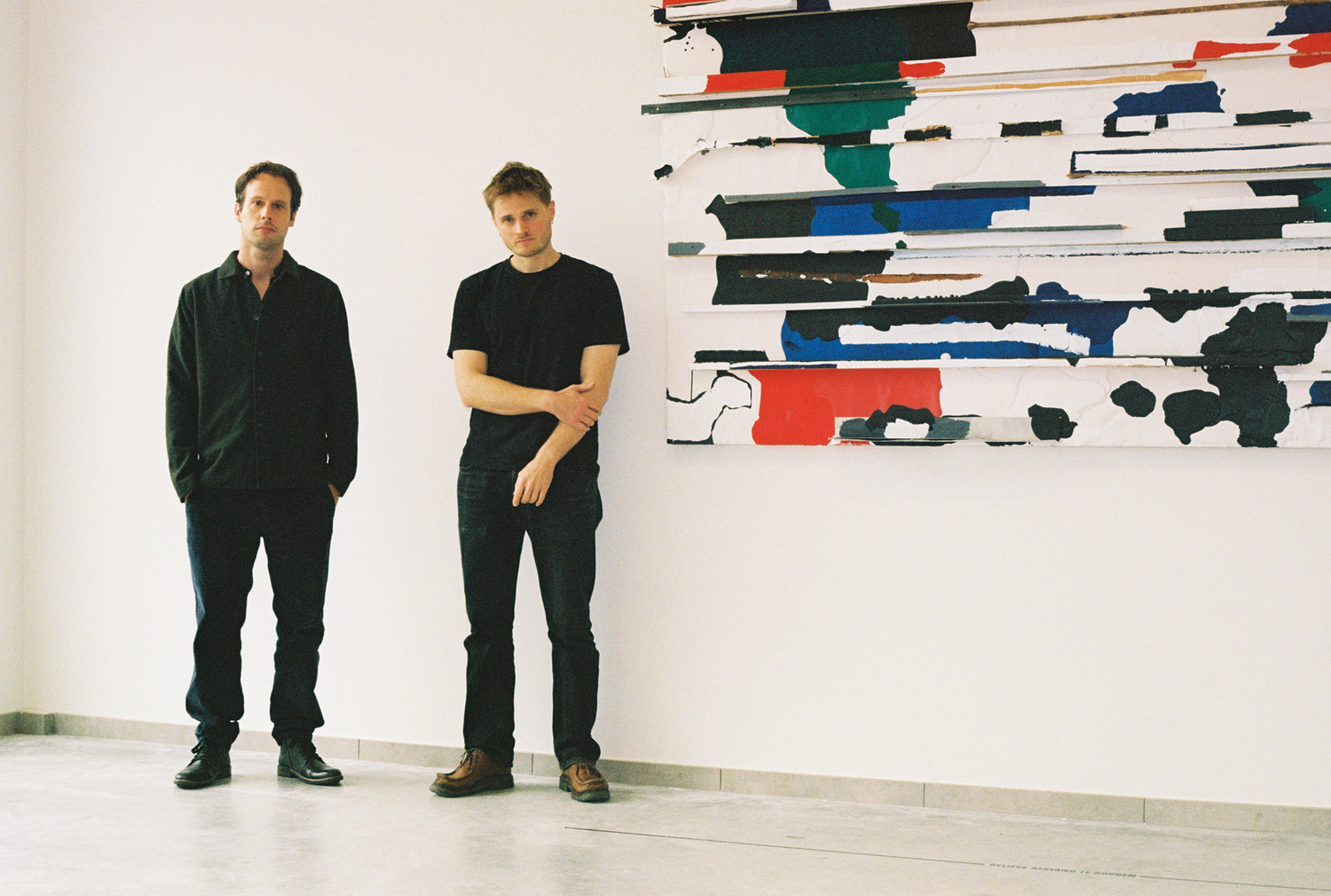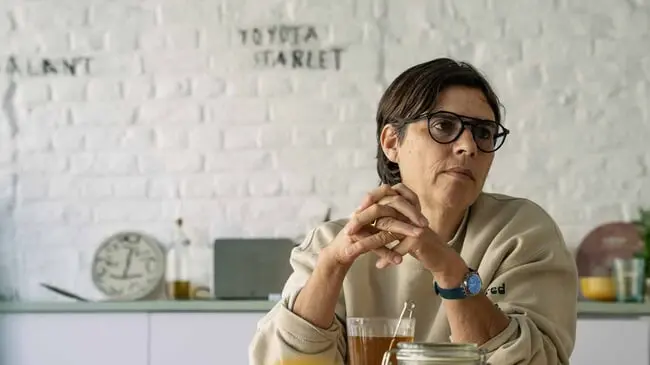Encounters at Be-Part: Rein Dufait and Jonas Dehnen

What if art isn’t necessarily about meaning, but about noticing? At Be-Part Waregem, Rein Dufait’s exhibition 'ginder de dingen, de dagen en de wolken' drifts between chance, memory, and tiny discoveries. Rein Dufait roamed the show with Brussels-based painter Jonas Dehnen, sharing thoughts on puzzles, layers, and the quiet thrill of making something without rules – where art can happen on its own terms.
Can you tell us about the elements in the exhibition’s title translated as ‘there, the things, the days and the clouds’?
Rein: The title has three parts: ‘there, the things’ as if you were pointing at something to look at ‘over there’, but you don’t know exactly where. It’s vague and concrete at the same time. The days suggest a layer of time-lapse, a rhythm and continuation in some works. Time is present in the sense that you could almost retrace the steps in the works. Clouds are imagination; everything that can’t be and isn’t – it’s what you cannot grasp or capture.
Paint is just a thing. To make something that cannot be thought up. Surprising an existing logic with a new logic. The pleasure of looking without having to think.
The pleasure of looking without having to think
<img class="editorial-image-50-left" src="https://cdn.prod.website-files.com/61eebcc683107b99137f4423/68e391a8bc13c5f1e005a136_000044_paulinecolleu_RGB_72_web.avif"/>
<img class="editorial-image-50-right" src="https://cdn.prod.website-files.com/61eebcc683107b99137f4423/68e391a6e0ec0afe784b2dd2_000045_paulinecolleu_RGB_72_web.avif"/>
The exhibition mentions inviting a slower way of looking and an appreciation of the materials and forms around us. Do you have an idea of how you want people to observe your work?
Rein: I think people can look however they want. I don’t mimic or copy the exciting ‘world’ or reality (what already is), but my work has traces and references to the outside world we live in. Paint is just a thing. To make something that cannot be thought up. Surprisingly, an existing logic with a new logic. The pleasure of looking without having to think.
Jonas: I'm also working mainly by myself in this kind of slow, iterative process, and I am also not trying to communicate something direct or explicit. However, I do make references to art history or to culture and some elements that are kind of recognisable if they're discussed. For me, the question of the ‘aboutness’ of the work is interesting, but it should stay implicit.
<img class="editorial-image-50-left" src="https://cdn.prod.website-files.com/61eebcc683107b99137f4423/68e391a899a28faa3afd0d27_000056_paulinecolleu_RGB_72_web.avif"/>
<img class="editorial-image-50-right" src="https://cdn.prod.website-files.com/61eebcc683107b99137f4423/68e391a32a6862e84a873cbf_000047_paulinecolleu_RGB_72_web.avif"/>
Jonas, you’ve described painting as ‘a treacherous ground’. Rein, your work embraces chance. In that regard, how do you both navigate authenticity in your fields?
Jonas: Painting is automatically a work of art; it has a safe status as no one questions its right to exist. Because it’s so well-worn, it’s necessary to find your own place in it. People have always made pictures with pigments on some type of support, and they always will. It’s beautiful – like singing or dancing, a fundamentally human thing to do. There's a bit of a fetish around painting’s authenticity because you can see the painter’s hand, what they did and how. While with conceptual work, authenticity is in the flavour of the idea, but you can never see it. Painting can also be a commodity. I don't know if those things are a detriment or a quality, but you can't deny them.
Painting is automatically a work of art; it has a safe status as no one questions its right to exist
Rein: Christophe Van Gerrewey wrote a text for my new book, In de verte - de lucht, where he can explain my practice much better. But I would say it is in between not caring about anything and caring enormously about certain things. Asking what it means is already accepting that it is.
<img class="editorial-image-50-left" src="https://cdn.prod.website-files.com/61eebcc683107b99137f4423/68e391a3d697cbcde5290bb3_000039_paulinecolleu_RGB_72_web.avif"/>
<img class="editorial-image-50-right" src="https://cdn.prod.website-files.com/61eebcc683107b99137f4423/68e391a8d2184c5306a795fa_000058_paulinecolleu_RGB_72_web.avif"/>
How would you say time and repetition shape your works?
Jonas: I usually paint with the surface flat on the ground, layering thin coats and erasing parts, so what’s left feels like little islands. The result is less an image and more like a map of itself. That process takes time. At the start, when the canvas is untouched, there’s complete freedom, and that feeling returns later, when it can’t get worse, and you’re free again. I cycle between those stages. To ease the tension, I work on several paintings at once (maybe up to eight), because I can’t focus on just one. Constant decision-making can be exhausting, so working across multiple pieces helps break that intensity. The application or removal of paint is rather fast, but you need time in between, so it’s a staccato process rather than slow.
That feeling returns later, when it can’t get worse, and you’re free again
Rein: The process is often intense and transformative. There’s no fixed trajectory; you mostly start from zero. Not being afraid to stop playing is key. Repetition is poverty. But I don't romanticise the process; only the result matters. Sometimes it's quick and easy, and that’s okay if I follow genuine curiosity. You don’t always need to know where to go – sometimes you just have to finish the piece. Less struggle is better, not to defy the sea, but to drift with it. Working on different series at once keeps things exciting and allows crossovers. The real challenge is having time in the atelier – once I am there, the rest follows.
Less struggle is better, not to defy the sea, but to drift with it
<img class="editorial-image-50-left" src="https://cdn.prod.website-files.com/61eebcc683107b99137f4423/68e391a668e2a733fac6dd3c_000041_paulinecolleu_RGB_72_web.avif"/>
<img class="editorial-image-50-right" src="https://cdn.prod.website-files.com/61eebcc683107b99137f4423/68e391a689a5744b2c0fd5df_000043_paulinecolleu_RGB_72_web.avif"/>
Memory seems to play a role – how do you each work with it?
Jonas: For me, memory is like a less explicit raw material. If an artist tries to address cultural memory, it can be a self-defeating impulse in a way, because it's difficult to stay in touch with a culture by making a different one at the same time. A painting can let me experience memories or combine them to make something new. In the Ghent exhibition (at Pizza Gallery), I used the pattern of my old school tie, which carries different connotations. People project their own meanings too, which I find interesting. It invites openness.
A painting can let me experience memories or combine them to make something new
Rein: Some of my work references older pieces, sometimes just because I reuse forms in different works. It happens without specific connotation. For example, a series I made, titled Odalisbkanen, it’s abstract, but the title was a reference to the Odalisque theme in painting. At Be-Part, one piece on canvas references Henry Moore’s King and Queen sculpture. I don’t strive for or hold on to it, but if it happens and I like it, it’s fine.
<img class="editorial-image" src="https://cdn.prod.website-files.com/61eebcc683107b99137f4423/68e391a87097dfb598a66671_000050_paulinecolleu_RGB_72_web.avif"/>
What would you both take away from this encounter? Any notes to share with other artists?
Jonas: It was nice to see Rein’s work again. I did an internship with him eight years ago, but I remember seeing your working environment at what was an impressionable time for me. It's interesting to see how your work has evolved, and I love seeing these callbacks to previous ways of working. I can relate to that impulse – bringing elements from your past into the present. It’s tricky for artists to find their way around their work and to deal with the reception of it, but anything goes. Define a play area, play, learn, and find a process that feels fulfilling.
Rein: It’s nice to meet again. I'm excited and curious to see Jonas’s show.
To answer your question, I don’t think I'm in any position to give advice. But whatever story you need to tell yourself to get moving is fine, as long as you generate ideas – good and bad – to select from. Just make it better than it was the day before. Follow what you enjoy most, find genuine curiosity, there’s something worthwhile – the rest is just noise.
Don't stay in your lane – there is no lane.
Relate to time, not to your own time.
Relate to time, not to your own time
<div class="editorial-banner"> <div class=“editorial-credits”>@reindufait / @jonasdehnen<br>@bepart_platform<br><br><br/>Rein Dufait - ginder de dingen, de dagen en de wolken<br>until 30.11.2025<br>Waregem, Be-Part<br/>be-part.be<br><br>Jonas Dehnen - A Legato or Your Perfect Hair In The Bathroom Sink, Adorning<br>until 19.10.2025<br>Ghent, Pizza Gallery<br>pizzagallery.be</div></div>
Different Class works with the interest of their community at heart.
Our work’s purpose is to foster a solid network for independent artists, those who love them, and those who want to support them. Become a member to contribute to the local Belgian art scene.






